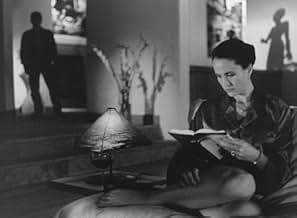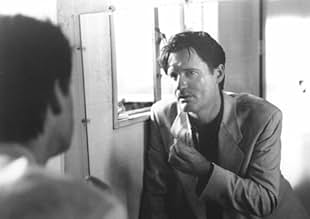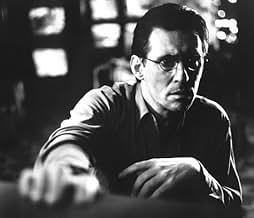CALIFICACIÓN DE IMDb
5.6/10
5.5 k
TU CALIFICACIÓN
Mike es un exitoso productor de Hollywood de películas violentas. Entonces él mismo experimenta una violencia extrema, desaparece, se une a unos jardineros latinos y revisa su vida.Mike es un exitoso productor de Hollywood de películas violentas. Entonces él mismo experimenta una violencia extrema, desaparece, se une a unos jardineros latinos y revisa su vida.Mike es un exitoso productor de Hollywood de películas violentas. Entonces él mismo experimenta una violencia extrema, desaparece, se une a unos jardineros latinos y revisa su vida.
- Premios
- 1 premio ganado y 4 nominaciones en total
Nicole Ari Parker
- Ade Kenya
- (as Nicole Parker)
Samuel Fuller
- Louis Bering
- (as Sam Fuller)
Opiniones destacadas
How 'bout a four? Visually, there are some great moments. I think the most interesting scenes are those where there is no dialogue but the camera follows the characters as they inwardly contemplate what this all means (Bill Pullman, Andie McDowell). Unfortunately, we as the viewers are also given (too much) time to contemplate what it means. Everything is WAY too understated. The movie slows to a stop in many places. You start to like it (the romance with Kat and the investigator, the interaction of Bill Pullman's character and the Mexican-American people) and then it doesn't follow through. The dialogue at the film school, in which the characters give a monologue for a class is probably the most interesting dialogue. Some rap, some tell a story, some recite their own poetry. That was the most moving part of the movie. While Wenders has a important point to make, it doesn't come through clearly and the viewer is left uncaring, uninterested. Maybe the only thing that could have helped the End of Violence is more good ole fashioned...violence <g>.
5=G=
"The End of Violence" is a clutter of stick figures wandering through a messy story about some sci-fi "big brother" government project being tested in Los Angeles. The film trades interesting characters for interesting situations, connects the dots too late revealing too little, and ends in a self absorbed coma about as flat as warm beer. Nonetheless, the film has a respectable cast, a garnish of neo-Beat poetry, a brooding noir feel, a good soundtrack, and some husky-voiced philosophical narration by Pullman making it a par watch for the needy couch potato. (C)
I don't think I've ever seen a movie that is so cerebral yet so poor at the same time. Wim Wenders is certainly revered in the film community for his offbeat ethereal productions (i.e. Wings of Desire), however, nothing profound or comprehensible can be extracted from his latest effort. It is as if four or five scripts were dropped in a studio parking lot by some clumsy intern and what was left was thrown together so that somebody wouldn't get fired. There are some common links between the characters but what does any of it have to do with the underlying plot of satellite surveillance? I kept waiting for the film to decide which plot it thought was most interesting, but it remained undecided to the very end. This was a frustrating experience to say the least.
The most aggravating aspect of this film is the fact that none of the parties involved appear to incompetent, so how is this movie so bad? Maybe I missed something...
The one saving grace of this film is the performance of Udo Kier as a German director. He alone mutters the one or two lines that managed to get me to crack a smile during this disaster.
The most aggravating aspect of this film is the fact that none of the parties involved appear to incompetent, so how is this movie so bad? Maybe I missed something...
The one saving grace of this film is the performance of Udo Kier as a German director. He alone mutters the one or two lines that managed to get me to crack a smile during this disaster.
You don't turn to Wim Wenders when you're looking for nerve-tightening suspense. Though written (by Nicholas Klein, with Wenders) in paranoid-thriller form, the script lacks even a nubbin of McGuffin to anchor the narrative. Two stories run in parallel: Bill Pullman's an action-film producer gone missing after an attempt on his life; Gabriel Byrne's a NASA computer jock on loan to a mysterious satellite surveillance project. Just as yuppie cop Loren Dean is on the point of tying the two tales together, the movie's over, the plot unresolved.
Oh, well: Los Angeles (mainly Malibu, Santa Monica, and Griffith Park) looks great (cinematography Peter Przgoda), and Wenders has an uncanny ability to get actors to feel comfortable in their skins. The most notable skin in question is Traci Lind's: her role as a stunt-woman turned aspiring actress would have made her a star in a more mainstream movie.
If you're a Wenders fan, don't let the commercial failure of this film put you off: Compared to, say, 'Far Away, So Close' it's as electrifying as 'The 39 Steps.' And somehow, as usual, Wenders's almost childlike intensity of gaze makes you look harder, too. The aroma of the film lingers, even as its substance slides through your fingers like sand.
Oh, well: Los Angeles (mainly Malibu, Santa Monica, and Griffith Park) looks great (cinematography Peter Przgoda), and Wenders has an uncanny ability to get actors to feel comfortable in their skins. The most notable skin in question is Traci Lind's: her role as a stunt-woman turned aspiring actress would have made her a star in a more mainstream movie.
If you're a Wenders fan, don't let the commercial failure of this film put you off: Compared to, say, 'Far Away, So Close' it's as electrifying as 'The 39 Steps.' And somehow, as usual, Wenders's almost childlike intensity of gaze makes you look harder, too. The aroma of the film lingers, even as its substance slides through your fingers like sand.
I watched this movie a few times, and I have met very few people who liked it as much as I did. I see it as an artful expression of all the critical thoughts in philosophy, sociology etc. that show how genocide, ultra-violence and fascist methods of population-control can develop out of all the promises of order, justice and peace the the modern state makes to its citizens. Also, the dialogue has absolutely superb moments, as when Mike the fugitive of the state says to his wife confronts his ex-wife with the words "Who can I turn myself into? Well I see who you turned yourself into...". A lot of people seem to dislike the loose ends and unexplained shifts that the characters make - but I say, in that very absence of rigid structure the film makes a parallel to the manifest ambivalence of modern life as a citizen: Our greatest protector is also our greatest threat.
¿Sabías que…?
- TriviaThere is a scene in the film where we see a live recreation of the painting "Nighthawks" by Edward Hopper.
- ErroresWhen Page is holding Mike at gunpoint she holds the gun upward with the bottom of the handle facing outward and the ammo clip is clearly missing. Yet when Mike exits through the patio door she fires the gun and shatters the glass.
Obviously there was a bullet in the chamber.
- Bandas sonorasBailare (El Merecumbe)
Written, Performed and Produced by Raul Malo
Courtesy of MCA Records, by arrangement with Universal Music
Special Markets
Selecciones populares
Inicia sesión para calificar y agrega a la lista de videos para obtener recomendaciones personalizadas
- How long is The End of Violence?Con tecnología de Alexa
Detalles
- Fecha de lanzamiento
- Países de origen
- Idiomas
- También se conoce como
- El final de la violència
- Locaciones de filmación
- Griffith Observatory, 2800 E Observatory Rd, Los Ángeles, California, Estados Unidos(Multiple interior and exterior scenes; as Ray Bering's workshop. Hillside hike viewpoint just south of observarory)
- Productoras
- Ver más créditos de la compañía en IMDbPro
Taquilla
- Presupuesto
- USD 5,000,000 (estimado)
- Total en EE. UU. y Canadá
- USD 386,673
- Total a nivel mundial
- USD 386,673
- Tiempo de ejecución2 horas 2 minutos
- Color
- Mezcla de sonido
- Relación de aspecto
- 2.35 : 1
Contribuir a esta página
Sugiere una edición o agrega el contenido que falta





































